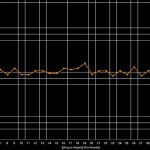If you are new to airguns, and you’re anything like I used to be, then you’re looking at that box, staring at 1200 FPS on the side. Obviously this means the airgun is better than the one next to it that says 1000 FPS. I mean, doesn’t it make sense that bigger is better?
If only it were that simple. It has taken me many years to realize the difference between velocity, energy and how they relate to accuracy. When you start looking at the fine print on the box you’ll see some very important words: “up to.” When it says up to 1200 FPS, it means that under perfect conditions, with the lightest weight pellet, this particular rifle, may possibly shoot up to 1200 FPS. This does not mean that it will perform 1200 FPS every time, or at all. It simply means that in testing it could possibly shoot up to 1200 FPS.
Crosman Lead Free Supersonic pelletsAs you learn more about airguns you’ll find that the weight of the pellet directly affects the velocity, so it’s important to understand how manufacturers come up with their velocity numbers. Nearly all vendors have some form of lead free, lightweight alloy pellet. For simplicity sake, will stick with .177 caliber as our reference point. A standard weight lead pellet is around 7.9 grains, a light lead pellet is around 7.0 grains, and a heavy lead pellet tops out at around 10.5 grains. So where do these lightweight lead free pellets come in for weight? Some come in as low as 4.0 grains. Essentially, you’re shooting a piece of lint out of your airgun. While this may go fast it certainly won’t be accurate and it really won’t go that far either.
With this basic information in mind, the numbers on the side of the box, i.e. 1200 FPS, 1000 FPS, 850 FPS, etc., start to have some relevance. As long as you know what pellet weight was used for their testing, then you can extrapolate how powerful the gun may be with a traditional lead pellet.
Once you’ve made your airgun selection, then you can begin working with different pellets to find the optimal weight and shape for your new airgun. For optimal accuracy and range most precision airgun shooters will agree that the mid-800 FPS to low 900 FPS is right about where you want your velocity to be for a sporter class airgun. This would be your typical target practice and small game hunting airgun capable of distances out to 40, 50, and 60 yards.
So this brings us to the next question: “Isn’t accuracy more important than velocity?” The short answer is, absolutely yes. But manufacturers don’t really talk about accuracy as they seem to want to only focus on velocity. So it’s up to us to do the legwork to see what really works and what doesn’t.
Traditional ballistic data tells us that a heavier projectile shot at a similar velocity to a lighter projectile will perform better than the lighter projectile. This applies to airgun pellets as well. To see the most accuracy at range, you will usually want to find the heaviest pellet that you can shoot while maintaining appropriate muzzle velocity. When you can find the right mix of pellet and velocity than you can see some great repeatable accuracy.
H&N Pellet SamplerIt can be quite the challenge to find that perfect mix. Fortunately several vendors have created sample packs of their pellets to ease the process. RWS, JSB, H&N, Gamo, and Crosman, all have sample packs that allow you to try several different weights in shapes without buying full tins of pellets that may not be useful in your airgun.
If you really want to understand how each will affect your airgun and its potential performance, then acquiring a chronograph is a great idea. This simple diagnostic tool will provide many different functions. The simplest function will be that it can accurately provide performance data on your rifle with any given projectile. As you learn more about your airgun and how it performs, a chronograph can be a great early warning system for warn parts such as seals and springs.
Without a doubt airgunning is a science all of its own. It’s incredibly challenging and rewarding for novices and old-timers alike. There’s always something new to learn and experience in the world of airguns. With new products and accessories coming on the market all the time it means that there will never be a shortage of new things to try.
If you would like to learn more about airgun velocity and what may be the right airgun for you, please visit our Airgun Education Center or give one of our airgun consultants a call. We’ll be more than happy to help.
